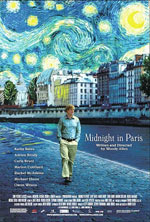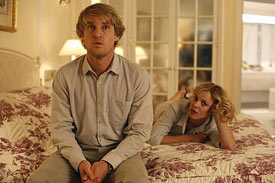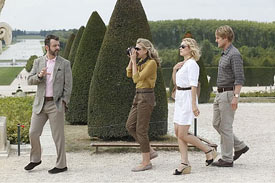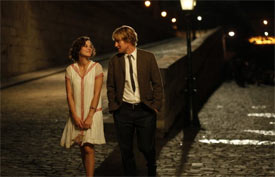
Midnight In Paris

 – for some sexual references and smoking.
– for some sexual references and smoking.
Director: Woody Allen
Starring: Owen Wilson, Rachel McAdams, Marion Cotillard
Running Time: 1 hour, 34 minutes
Theatrical Release Date: May 22, 2011
Official Site

Plot Summary
Midnight in Paris is a romantic comedy that follows a family travelling to the city for business. The party includes a young engaged couple that has their lives transformed throughout the journey. The film celebrates a young man’s great love for Paris, and simultaneously explores the illusion people have that a life different from their own is better.
(from MovieWeb.com)
Film Review
Feeling as though the life of another person or maybe even life during another time may have been sweeter than what we have presently probably isn’t a foreign concept to most people. Very few people haven’t looked at a celebrity, family member or even a friend and envied what they have. And almost as many of us may have pondered what it would have been like to have been born in another decade or even century. This is exactly the problem that Gil Porter is facing in Woody Allen’s latest directional effort, Midnight In Paris. Judging from the film’s overlong introduction of just shot after shot after shot of different views of the city of Paris, you might think that this film is solely an obsessive love letter for the popular, elegant city, but by the time the credits roll, you realize just what it is that Allen was trying to say with Midnight In Paris, and it’s something most of us can relate to.

I’ve never been a fan of Allen’s work, although I loved his vocal contribution to the animated film Antz in the late 90’s. Since then, Allen seems to have slipped pretty far from the pedestal that critics had set him atop some time ago. He’s gone from making much-praised indie films to frequently forgotten follow-ups. But his latest film, Midnight In Parishas captured the hearts of not just moviegoers but those finicky critics themselves. And after watching it, you realize just what was so appealing. For starters, Allen has assembled a very impressive cast with Owen Wilson leading the pack as a struggling novelist. To support Wilson is Rachel McAdams, who plays his feisty fiance, Inez, who may not fully have gotten over a previous thing she had for her now-married friend, Paul (Michael Sheen), who accompanies Wilson and McAdams on various artistic journeys throughout Paris with his wife by his side. However, the city – and his growing discontent with the company he’s keeping – forces him into the streets of Paris to walk them alone one night. It’s there that something incredible happens. At the stroke of midnight, Gil finds an antique car driving up in front of him and the occupants of it welcoming him inside. He soon finds himself surrounded by his literary and artistic heroes as, somehow, he’s traveled back in time to the 1920s. And this is where the fun begins.
Allen makes Midnight In Paris feel magical without seeming fantastical and whimsical without feeling too cartoony or abstract. His execution nearly seems realisic – if not possible – and that helps build on the charm of the story. It only helps that Allen fills his 1920s era with a great cast. Corey Stoll steals every scene as the equally intimidating and intriguing Ernest Hemmingway, while the lovely Marion Cotillard (Inception) is enchanting as Adriana. Alison Pill (Dan In Real Life) is a real spitfire as Zelda Fitzgerald and Tom Hiddleston (Thor) shows a much lighter side this time around as her jealous husband, F. Scott Fitzgerald. Adrien Brody makes a brief appearance as Salvador Dali for one of the film’s most memorable and brilliant moments as Gil tries to explain his time-travelling to a receptive table of surrealists. But we all know from films past that great talent doesn’t guarantee a strong product. Allen does a wonderful job recreating the eras featured in the film and an amusing and fun script seals the deal (Allen directed and wrote this film). But love him or hate him, Owen Wilson turns in one of his best and most charming performances as Gil as he acts and reacts within the different extraordinary situations. He’s easily relatable to in this story, even if he’s not making the most wise decisions all the time.

The only real downside to Midnight In Paris lies within some of its content. Amazingly enough, there isn’t much profanity at all in the film. However, the majority of what is included is, sadly, blasphemy. When it’s uttered, it feels all the more out of place and unnecessary as the script seems to get on just fine with otherwise no other profanity (save for just a couple uses of “h*ll” and 1 “d*mn”). It’s really unfortunate. Otherwise, this film takes on a much more mature tone thematically with there being excessive drinking throughout the story and some conversations about sexual situations (like affairs the artists of the past have had or inspirations for artwork) and even the theme of cheating on a fiance or spouse. The theme of love isn’t sugarcoated to be pretty and pristine, which is realistic from a worldview but not from a Christian view, but Allen uses it to drive home the film’s biggest theme, which I won’t spoil here (but I’ve already touched on it a bit, regardless). While the historical exploration of the 1920s era brings those famous artists to life before our very eyes, making history rather fun and exciting, this isn’t another Night At The Museum and not a movie for the whole family, unfortunately. It may be a bit less crude or edgy than most films in such a genre (or rating), but Allen was clearly more concerned with showing a contrast in overall lifestyle from 90 years ago to now, than creating a movie for all audiences.
It’s difficult to talk about Midnight In Paris without going into great detail (I was surprised to only be able to find one still photo from the film from when Gil is in the ’20s, which proves the filmmakers even want to keep the film’s magical elements a secret), but a strong cast, script and story make this a really enjoyable film. It’s more than just a love letter to the romantic city, but it does showcase the city in a way that it’s a character in the film itself (much in the way that Venice was for The Tourist). This film will make you want to visit Paris (and see if anything really happens at the stroke of midnight), if you haven’t already. Delightful and enjoyable from start to finish, Midnight In Paris isn’t for everybody – and certainly not the whole family – but it’s one that fans of art and literature would be most interested in checking out.
– John DiBiase (reviewed: 6/29/11)
Parental Guide: Content Summary
![]() Sex/Nudity: Gil makes a comment is made about alcohol and pheromones and Paul agrees, referring it to something like wine and sex; Many mentions of historical artists having affairs and mistresses are made throughout the movie; We see a Picasso painting twice that has an abstract woman apparently naked on it but there is no explicit detail as the image on the painting has absolutely no realistic portrayal of a person on it; Gertrude Stein explains the painting to Gil about it being more about sex and Picasso’s love affair with the subject than about actually painting her – comparing their lovemaking to like that of a volcano. Gil repeats this almost verbatim when he and his friends see the painting in the museum (saying the girl was “a volcano in the sack” or something like that); Behind them during this scene is a painting, which isn’t entirely realistic, which shows a woman with most of her left breast hanging out; We see Inez in just a towel after a shower and Gil tries to caress her a bit, but she pushes him away; The museum guide reads a diary to Gil that talks about how this girl had met an American writer and that she dreamt he brought her a gift and that they “made love.” Gil then tries to find a gift for her in hopes of making it come true; We briefly see some French hookers standing on a street corner in 1920s lingerie-style garb and Adriana asks Gil if they appeal to him. He then jokes that they definitely do; Dali talks about two rhinos mounting each other for sex; A woman admits to cheating on another man. [There may also be some other sexually related dialog or minor innuendo that I’ve missed]
Sex/Nudity: Gil makes a comment is made about alcohol and pheromones and Paul agrees, referring it to something like wine and sex; Many mentions of historical artists having affairs and mistresses are made throughout the movie; We see a Picasso painting twice that has an abstract woman apparently naked on it but there is no explicit detail as the image on the painting has absolutely no realistic portrayal of a person on it; Gertrude Stein explains the painting to Gil about it being more about sex and Picasso’s love affair with the subject than about actually painting her – comparing their lovemaking to like that of a volcano. Gil repeats this almost verbatim when he and his friends see the painting in the museum (saying the girl was “a volcano in the sack” or something like that); Behind them during this scene is a painting, which isn’t entirely realistic, which shows a woman with most of her left breast hanging out; We see Inez in just a towel after a shower and Gil tries to caress her a bit, but she pushes him away; The museum guide reads a diary to Gil that talks about how this girl had met an American writer and that she dreamt he brought her a gift and that they “made love.” Gil then tries to find a gift for her in hopes of making it come true; We briefly see some French hookers standing on a street corner in 1920s lingerie-style garb and Adriana asks Gil if they appeal to him. He then jokes that they definitely do; Dali talks about two rhinos mounting each other for sex; A woman admits to cheating on another man. [There may also be some other sexually related dialog or minor innuendo that I’ve missed]
![]() Vulgarity/Language: 1 “J*sus Chr*st,” 8 derivatives of “G-d,” 3 “h*ll,” 1 “d*mn,” 2 “Chr*st”
Vulgarity/Language: 1 “J*sus Chr*st,” 8 derivatives of “G-d,” 3 “h*ll,” 1 “d*mn,” 2 “Chr*st”
![]() Alcohol/Drugs: There is lots and lots of drinking throughout the entire movie. We see people at a wine tasting event where Gil gets drunk. He later climbs into the back of a car where everyone is drinking and they stop at a party where there is a bar and everyone is drinking. Some other scenes take place in bars and we see people regularly drinking.
Alcohol/Drugs: There is lots and lots of drinking throughout the entire movie. We see people at a wine tasting event where Gil gets drunk. He later climbs into the back of a car where everyone is drinking and they stop at a party where there is a bar and everyone is drinking. Some other scenes take place in bars and we see people regularly drinking.
![]() Blood/Gore: None.
Blood/Gore: None.
![]() Violence: Hemmingway asks “Who wants to fight?” but there isn’t any fighting; Hemmingway also tells a few violent stories from when he was in the war; We see a man fleeing a place of royalty with people crying “Off with his head!” (played for laughs. We don’t see the person caught or hear of anything happen to them)
Violence: Hemmingway asks “Who wants to fight?” but there isn’t any fighting; Hemmingway also tells a few violent stories from when he was in the war; We see a man fleeing a place of royalty with people crying “Off with his head!” (played for laughs. We don’t see the person caught or hear of anything happen to them)
